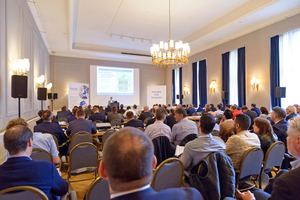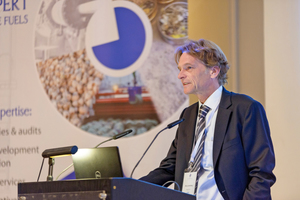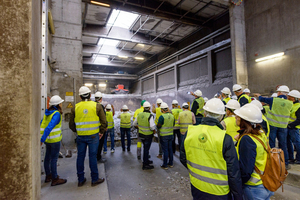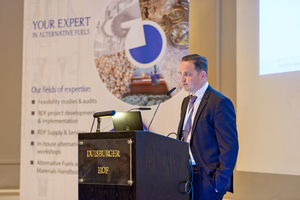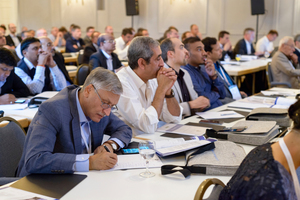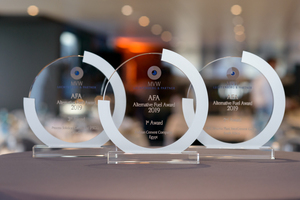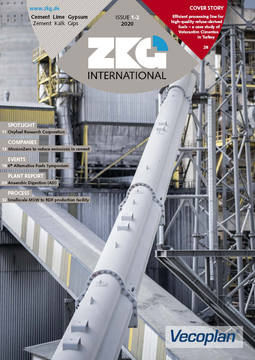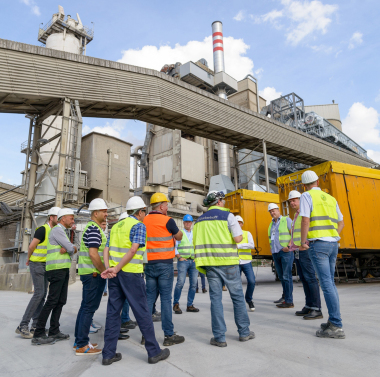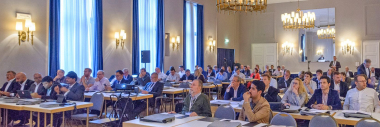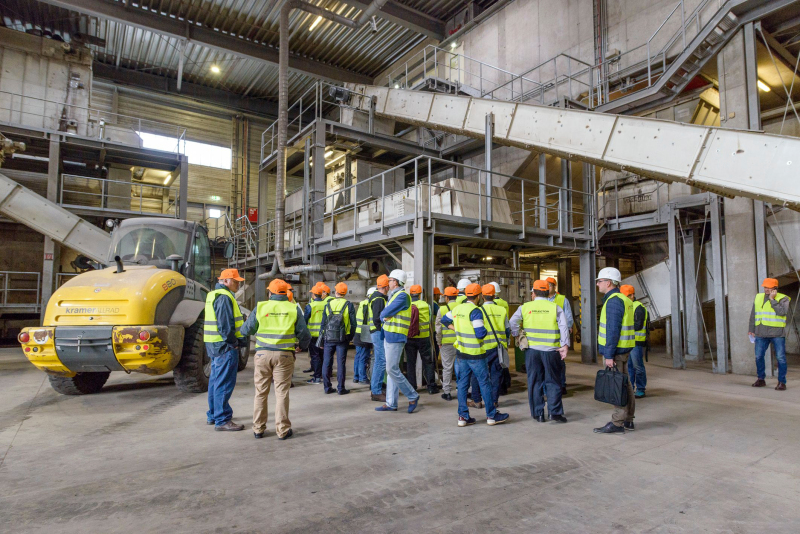6th Alternative Fuels Symposium with field trip to HeidelbergCement
From 23.09.-25.09.2019, around 130 attendees met for the 6th Alternative Fuels Symposium in Duisburg, which was organized by MVW Lechtenberg & Partner. The field trip traditionally arranged on the first day led this time to the Ennigerloh plant operated by HeidelbergCement. This plant has replaced more than 75 % of fossil fuels with alternative fuels. At the subsequent symposium, the experts were updated about new developments in the field of alternative fuels.
1 Substitute fuels in field operation
On the Tuesday afternoon, this year’s field trip took the group to Ennigerloh and the cement plant founded in 1909 under the name Anneliese Portland-Cement und Wasserkraftwerke AG, which is now a HeidelbergCement facility.
The plant already uses more than 75 % alternative fuels, such as RDF, tyres and liquid fuels. Besides viewing the plant‘s tyre feeding system, the attendees were also given the opportunity to see the RDF storage area, find out about the cement plant’s experience with the installations and discuss these with the experts on site.
2 Substitute fuels in all their diversity
Dirk Lechtenberg, MVW Lechtenberg & Partner, was delighted to welcome more than 130 attendees from 37 countries to the symposium: It was particularly positive, he said, that many attendees had come to Duisburg from developing and emerging countries. Especially in these countries, great potential still exists for the use of alternative fuels, to contribute to making the cement industry greener. As an example, he mentioned India, here with the use of alternative fuels, around 50 million t CO2 could be saved.
With over 20 presentations on the use of alternative fuels, the subsequent technical programme addressed a wide array of topics. Particular importance was attached to the presentation of case studies so as to ensure practical relevance. Country and regional reports included case studies from various regions around the world. The supplier industry informed attendees about new technologies for the use and production of alternative fuels and the latest plant technology in talks and an accompanying exhibition.
In the opening paper, Prof. Dr Estelle Herlyn, Competence Centre of Sustainable Development at FOM University of Applied Science, gave a basic overview on the worldwide CO2 emissions. Besides all the efforts that industry is making to reduce CO2 emissions, non-industrial and very effective solutions are available that can also be realized very quickly. One of these is the protection of the rainforest. Fundamentally, focus should also be shifted to the utilization of the CO2 formed as a raw material.
In a field report headed “State-of-the-art technology in emission reduction”, Florian Salzer, Wietersdorfer & Peggauer Zement GmbH, outlined the activities of the cement plant in Wietersdorf. The company has the ambitious goal of becoming one of the cleanest cement plants in the world. To achieve this, Wietersdorfer Zement has invested in the reduction of SO2, NOx and mercury emissions (installation of a SNCR system, renewal of the baghouse filter and the erection of a regenerative thermal oxidation system). CO2 emission reduction is also one of the most important targets for w&p Zement. Salzer sees the following starting points here: low-CO2 fuels, use of partly pre-calcined alternative raw materials, development of cements and binders with low clinker content, continuous reduction of the electrical energy consumption and electricity generation with company-owned hydropower plants. To achieve that, two new hydropower plants are being built in 2020 and 2021. The company’s own electrical energy supply to clinker and cement production should reach > 25 %.
“Incineration of sewage sludge at Schwenk Cement KG” was presented by Hans-Joachim Walther, Schwenk Zement KG. Schwenk uses more than 1 million t alternative fuels and materials from residues each year. Besides used tyres, waste wood and RDF/fluff, these include sewage sludge, too. In the period 2004 to 2018, the plant used around 4 million t. Precondition is strict control by the laboratory, as chemical ingredients significantly limit the use of sewage sludge (for example phosphorus). Schwenk is investing in future-oriented plant technology for exhaust air cleaning (SCR, DeCONOx, Xmercury, biofilter) and technological equipment (sludge dryer, sewage sludge warehouses, conveyor systems, fuel dryer).
In his paper entitled “Power plant post-combustion carbon dioxide capture”, Dr Georgios Koufodimos, Herhof GmbH – Helector SA, presented an innovative technology: Enzyme-Accelerated CO2 capture. This uses carbonic anhydrase (CA) enzyme. The CA catalyzes CO2 capture as compared to conventional technologies. This new technology uses salt solutions rather than the toxic solvents used by other capture technologies. The technology has been successfully tested in a 10 t/d pilot plant in Canada, with 2500 h of operation. Planned are a pre-commercial plant with 16 t/d in 2022, and for 2023 a commercial plant with 30 t/d. An application in the cement industry was feasible, he said, adding that retrofitting was viable in existing plants.
In the other papers presented on the day, representatives of the supplier industry, e.g. Vecoplan and Di Matteo, reported on their machines and equipment as well as case studies.
3 The use of alternative fuels worldwide
On the second day of talks, the programme included further field reports on the use of alternative fuels worldwide.
An “Overview of the cement industry in Pakistan & DG Khan’s RDF activities” was given by Dr Arif Bashir, DG Khan, Pakistan. The cement producer produces at three locations in Pakistan, Multan, Karachi and Lahore. Dr Bashir described the use of substitute fuels with the reference to the example of an RDF processing plant at Khairpur Cement. In September 2010, the company began with the installation of a first shredder and a conveyor system, in August 2011 a pre- and re-shredder were installed, which were followed by two tyre shredders by 2014. In extensive tests with mixes of coal and different alternative fuels (RDF, MSW, TDF), both the calorific value and the fuel costs were monitored, and the properties of the clinker ana-lysed. Bashir summed up the results as follows: Minimum impact on kiln operation, no production loss, higher fuel consumption owing to the high moisture in MSW, substantial cost saving depending on coal price, no negative impact on refractory, reduction in NOx and product quality retained.
The “Alternative fuels in Russia – current market situation and development trends” was the topic addressed by Konstantin Bojinov, Geocycle. In Russia, there are 52 cement plants with total capacities of 83 million t. Every year, 60 – 75 million t of municipal waste are generated in Russia. 96 % of the total MSW volume is landfilled and only 4 % of total volume recovered. Russia would like to reduce landfilling by 60 % by 2025. Before a radical introduction of substitute fuels in Russian cement plants can take place, however, open issues, especially with regard to approvals, must be resolved. In the two LafargeHolcim plants Shurovo and Ferzikovo, the use of MSW and used tyres has increased considerably since 2015. According to Bojinov, it is only a question of time until the use of alternative fuels increases generally in the Russian cement industry because the price of fossil fuels will rise.
In his talk, “Waste incineration in the European context between risks and opportunities”, Arian Middleton, EEW GmbH informed attendees that in the EU28-countries 88 million t energy from waste capacities and 11 million t co-incinerator capacities exist. Middleton outlined the expected scenarios and risks. For co-incineration (cement), an additional potential of around 5 million t is expected.
Under the motto “Alternative fuels in Greece”, Dimitrios Bakoulis, Antipollution S.A., stated: “It is worth mentioning that only the cement industry in Greece is using alternative fuels. AF have never been used in any other industry.” In Greece, there are currently eight cement plants. In 2012, the substitution rates in Greece for waste-derived alternative fuels were very low; on average between 6 – 7 %, owing to limited availability of suitable materials, an uncertain and lengthy permission process for co-processing. To date, the substitution rate of AF has reached 12 %. The government plans to increase recycling rates and reduce landfilling. Energy recovery options play a secondary role in the country’s waste management. The cement industry is prepared to use AF, but, amongst other things, suitable collection and treatment systems must be available and bureaucratic hurdles removed.
Ram Badanmani Tripathi, J.K. Cement Works, explained the “AFR journey from 2 % to 10 % TSR” at J.K. Cement, one of the largest white cement manufacturers in the world. With the use of AFR, the percentage of petcoke can be reduced and a cost saving achieved while clinker quality maintained. At the same time, a CO2 reduction of 4000 – 50000 Mt/month is achieved. To achieve the goal defined in the company’s AFR roadmap, that is to increase the TSR percentage to 30 % by 2022, the following investments are planned: Installation of a shredder, modification in the AFR discharge chute to calciner, control of the burning system to increase the AFR feed rate, a new AFR lab and so on.
4 Alternative Fuel Award
The last three talks of the day were held by the winners of the “Alternative Fuel Award”, which had been presented on the Wednesday evening at the attendees’ dinner on a Rhine ship. The awards were presented to the following winners:
1st Prize: Arabian Cement Company, Egypt:
“Alternative Fuel Case Study”
2nd Prize: Simuma Cement, Part of Intercement Group, South Africa: “5 Years Evolution for a Sustainable Waste Disposal”
3rd Prize: Process Solution, Canada:
“Waste Fuels Information Management System (WFIMS) for Geocycle”
Mir Kazim Ali, PSCL, started this series of talks with his remarks on “Waste Fuels Information Management System (WFIMS) for Geocycle”. PSCL deploys over 60 cement laboratory systems in cement plants around the world and is a pioneer in the analysis and tracking of waste material in alternative fuel streams. PSCL’s Waste Fuels Information Manifest System (WFIMS) supports cement producers’ goals to use alternative fuels including refuse-derived fuels (RDF) as a means to transition from a linear value chain to a circular economic model. The system comprises the points Material Qualification, Material Receiving & Storage and RDF Material Processing & Destruction. Ali explained the advantages of the system with reference to the example of LafargeHolcim. The WFIMS interface was developed in partnership with Geocycle and PSCL project team members.
“Coprocessing in Simuma plant – 5 years evolution of a sustainable waste disposal” was the subject addressed by Rafael Fenerich Mauri, InterCement South Africa. Most cement companies in South Africa use coal as their main fuel. South Africa has banned liquid waste with a calorific value of > 20 MJ/kg from landfill disposal. Therefore, alternative and sustainable solutions are sought for this. In NPC Simuma, possibilities are being created to use solid and liquid waste as a substitute for fossil fuels in the two kilns. In Kiln 1, since 2014, whole tyres and in Kiln 2 since 2019 shredded tyres and RDF have been used. Moreover in the two kilns, liquid alternative fuels have been used since 2017.
To conclude, Hazem Moshir Khater, Arabian Cement Company, as a representative of the winner of the Alternative Fuel Award explained the “ACC Alternative fuels usage journey and vision 2013 – 2019”. He discussed the various investments for AF use and to reduce the CO2 footprint. While the company started with 4 % AF in 2014, the percentage had increased to around 16 % by 2019, to 20 % at the peak.
4 Outlook
The 6th Alternative Fuels Symposium 2019 again combined practice and theory and offered the international public a wide spectrum of topics. Case studies and the presentation of new and further developed technologies were complemented with an accompanying company exhibition. Here, the attendees had the opportunity to discuss concrete problems directly with suppliers.
The 7th Alternative Fuels Symposium 2020 will take place again in Duisburg from 08.09.-11.09.2020.
//www.lechtenberg-partner.de" target="_blank" >www.lechtenberg-partner.de:www.lechtenberg-partner.de

